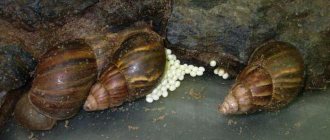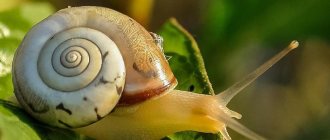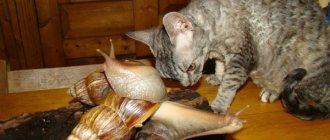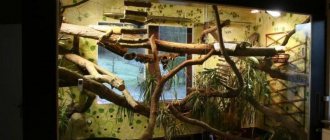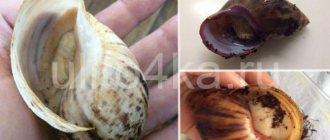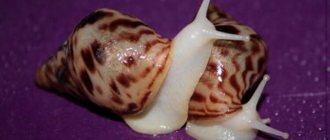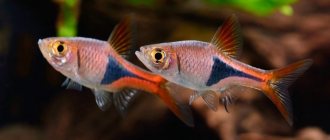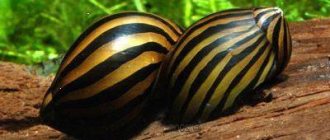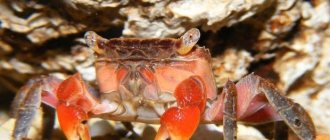Description
Snails are gastropods with a spiral outer shell. The structure includes a head, a leg and a bag of entrails. They move along surfaces using their legs, which secrete mucus. The body size of snails varies among species from a couple of cm to several tens.
How long do they live at home?
The lifespan of snails at home depends on their size, breed, and natural habitat. Aquatic snails have a short lifespan and do not exceed 4 years. Shellfish, which live primarily on land, live up to 10 years. Some long-lived species, for example, the grape species, can live up to 20 years.
Basic methods
There are two most popular options for feeding a snail:
From plastic dishes.
In this case, a suitable container with clean water is placed in the terrarium, from which the animal drinks on its own. You just need to choose the appropriate size, because even an adult can drown in a very deep bowl. Achatina climbs directly into the vessel and absorbs moisture with its whole body.
By moistening the soil.
It is convenient to use a spray bottle for this purpose. The fact is that in the natural environment where snails live, it is almost always humid. Therefore, in the aquarium you need to spray the walls, soil and the mollusk itself, and do this regularly. Then your pet will not feel thirsty. However, it is important not to overdo it and not turn Achatina’s habitat from a cozy house into a swamp.
Content
Keeping a pet snail is not difficult. But in order for a pet to live a long life, it needs to create favorable living conditions.
Choosing housing
When choosing a home for a snail, consider the pet’s natural habitat. Terrariums, containers, and molluscaria with a volume of 10 liters or more per individual are suitable for land snails. For aquatic shellfish, purchase an aquarium. Remember that not all aquatic mollusks can get along with aquarium fish. A 5 liter container is suitable for 1–2 aquarium snails.
Arrangement
The terrarium or aquarium should be equipped with small holes or narrow slits through which air will pass and excess moisture will evaporate. Pets can easily get out through large holes; also, a large number of holes can lead to dry air, which can be detrimental to snails. For land snails, ventilation is not at all necessary - they only need the air that enters the terrarium every day when cleaning and feeding.
To arrange suitable housing you will need:
- substrate for the bottom;
- terrarium cover;
- lids or plastic feeding bowls.
Substrate
A layer of substrate is laid out at the bottom of the molluscarium or terrarium. Coconut substrate, compost without fertilizers or peat are suitable for the substrate at the bottom of the terrarium; a small amount of sand or nut shells is allowed. Clay, wood shavings or bark are not allowed.
Lighting
A terrarium with mollusks does not need separate lighting, because the life of snails does not depend on daylight hours and lighting intensity. But observe the daily cycle of day and night. They are active at night and hide during the day.
Caring for pet snails
General rules of care and maintenance for all types of snails.
- Cleaning the terrarium 1-3 times a month for aquarium snails and daily cleaning for land snails.
- When caring for aquarium snails, replace the substrate every six months to a year.
- Water procedures. Land mollusks need spraying and washing with warm water. However, if the humidity level is favorable, there is no need for spraying - the snails have enough condensation from the walls.
- Remember about hibernation - this is the main signal of a problem. The pet hibernates when the ambient temperature drops or the humidity level is incorrect. If this happens, carefully examine the snail, the terrarium, and begin to eliminate deficiencies in the contents.
Taking care of your sink
A healthy and intact shell is an important sign of the health of the mollusk. It requires proper care. In order for the shell to be strong and quickly recover when chipped, the snail must have constant access to calcium supplements (sepia, powdered eggshells, natural chalk without additives).
Nutrition
The frequency of feeding depends on the age of the mollusk. Small representatives require feeding several times a day, while adults are fed once every 1–2 days. The pet can go without food for up to 2 weeks, but you should not abuse this.
The daily diet of snails mainly consists of vegetables, fruits and vegetation. We wrote more about snail nutrition separately.
Authorized products:
- Vegetables (tomatoes, cucumbers, cabbage).
- Fruits (bananas, apples).
- Leaves (grape, dandelion, spinach, lettuce).
- Berries (strawberries, wild strawberries, raspberries).
- Oatmeal, bran.
- Protein feeding 1-2 times a week (gammarus, daphnia).
What not to feed:
- Spicy.
- Roast.
- Smoked.
- Sweet.
- Salty.
- Citrus (oranges, lemons, tangerines).
- Pasta.
- Bread.
What to feed Achatina
Snails are extremely unpretentious in food, they are vegetarians, and therefore you do not have to spend a lot and worry about food for your pet. Snails' favorite delicacies are lettuce, apples, and cucumbers. They happily eat bananas, carrots, cabbage leaves, watermelon and even tomatoes.
Allowed vegetables and fruits include beets and tangerines. Offer them to your pet; if the snail doesn’t like the treat, don’t insist, everyone has their own tastes.
Remember that snails should absolutely not be salted, fried or smoked. Do not offer Achatina junk food if you want to keep your pet healthy.
For a strong snail shell, it needs mineral nutrition. A mineral stone for birds, which can be purchased at any pet store, is suitable for this purpose. It is best to feed snails in the evening, because the main peak of Achatina activity occurs at night.
Diseases, prevention and treatment
Mollusks are quite sensitive and do not have strong immunity and strong health, so you will have to protect your pet from possible illnesses and diseases by properly caring for snails.
- Overheat. When overheated, clams lack body fluids and are unable to produce enough mucus to protect the body.
- Hypothermia. Due to their constantly wet body, mollusks are especially prone to hypothermia.
- Hypovitaminosis. Occurs when there is a lack of any vitamin in the mollusk’s diet. Calcium deficiency is especially dangerous. Calcium is necessary for the construction of the shell and if it is deficient, any chipping will become a serious problem. For treatment, diversify your diet with dandelion leaves and flowers, and provide constant access to calcium. Pets also need protein supplements (gammarus, daphnia), which should be added to the diet a pinch 1-2 times a week.
- Shell injuries. Small fragments of the shell will still grow back, but if the pet has completely lost the shell, then it becomes non-viable. Infections and fungal diseases lead to shell loss.
- Parasites, worms. They enter the body from poor-quality food, soil or non-compliance with hygiene rules. For treatment, you will need antiparasitic or anthelmintic agents, as well as a complete replacement or treatment of the soil (boiling or calcining in the oven).
Prevention
Follow the rules of hygiene: wash your hands before contacting your pet with plain water without using chemicals, promptly clean the container or terrarium from mucus and food waste. Prevent food from rotting and choose healthy foods.
The best prevention is proper care, timely cleaning of the terrarium and complete treatment or replacement of the soil every six months.
How to bathe properly
To bathe the snail you will need a shallow container. This could be a special bathing suit from a pet store or an ordinary bowl.
Bathing water must be warm, boiled or filtered. The water should not be too cold or hot. The optimal water temperature is 30-33 degrees. Use the same water to spray the snail with a spray bottle.
Pour a small amount of water 2-4 centimeters into the bath, depending on the size of the pet. The water level should be at the level of the animal's spiracle.
Rinse the clam shell to remove any stuck-on lumps of soil and food. The snail can sit in a container of water for a while or immediately get out of it. As soon as the snail comes out of the water, the bathing is over. And don’t push her back into the bathing suit, don’t force her to experience stress.
It is not advisable to bathe a snail under a tap, but if you are very careful and careful with your pet, then rare procedures can be performed under a tap. Open and adjust the water to the required temperature. The water should flow in a thin stream. Place your pet on your palm so that the water hits your hand first and then the pet. Carefully wash the sink to remove dirt. If the dirt cannot be washed off with water, use your finger or a soft toothbrush.
After water treatments, you can wipe your pet's shell with sesame oil or olive oil using a piece of soft cloth.
Never use detergents or cleaning products to wash snails!
Adviсe
- Place the molluscar in accessible places, but not in walk-through rooms.
- Don't overfeed spinach.
- Ensure optimal humidity levels and constantly monitor the temperature in the terrarium.
- Peaches make snails' mucus watery, so it's best to remove this fruit from their diet.
- Pets love cucumbers and sometimes refuse other food, but cucumbers do not bring them any benefit.
- Avoid drafts.
- Avoid contact of shellfish with salt, sugar and chemicals.
Shell diseases
Thinning of the shell, its peeling is most often a reaction to a lack of calcium and vitamins in the diet. Also, problems with the sink may indicate a helminthic infestation, fungal disease or other diseases. It is necessary to adjust the diet and monitor hygiene. After bathing, the shell is lubricated with propolis ointment or burdock oil.
A snail with a damaged shell must be removed from its neighbors. The menu includes more than usual crushed chalk, eggshells, and sepia. Minor physical damage to the shell can be “patched” using a plaster or medical glue BF-6. In this case, the glue should under no circumstances touch the body of the mollusk. It should not be poured onto the damaged area, only applied in a thin layer. Eggshell film is also used as a patch; it is glued over the damaged area.
